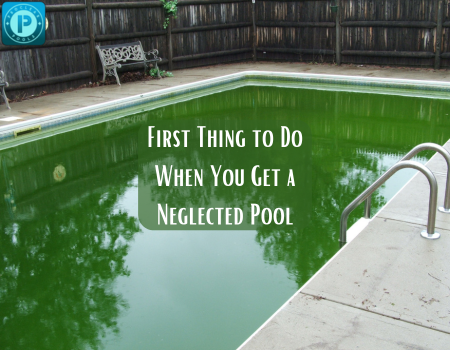Inheriting or discovering a neglected pool may seem daunting at first, especially if it’s filled with cloudy water, debris, or signs of algae growth. But with the right steps, you can restore a neglected pool to a clean, safe, and inviting oasis.
How to Handle a Neglected Pool
-
 Assess the Condition of the Neglected Pool
Assess the Condition of the Neglected Pool
Before diving into any cleaning efforts, thoroughly assess the pool’s current condition. Look for visible issues, including:
– Debris: Leaves, branches, and other debris can accumulate, especially in outdoor pools.
– Algae and Bacteria Growth: If the pool is green or murky, it’s likely infested with algae, which will require specific treatment.
– Water Chemistry: Test the water using a pool test kit to check the pH, chlorine, and other chemical levels. Knowing where the water chemistry stands will guide your next steps.
– Damage to Pool Equipment: Inspect filters, pumps, and the pool’s plumbing for damage or clogging. Sometimes neglected pools also have cracked tiles or damaged liners.
A good assessment will help you determine the right cleaning process and identify any repairs needed to get the pool fully operational.
- Remove Large Debris from your neglected pool
Start by removing large debris like leaves, twigs, and other visible contaminants using a pool skimmer or a net. Removing these items prevents clogging your filtration system and makes the water more manageable for the next steps. If there is excessive debris, you may need to use a leaf rake or pool vacuum for a more thorough cleanup.
- Drain the Pool (if Necessary)
For extremely neglected pools, draining and refilling may be the best way to start fresh, especially if the water is dark and heavily contaminated. However, check local regulations, as some areas restrict pool drainage. If you make the decision to have the pool drained:
– Turn off all equipment to avoid damaging it.
– Use a submersible pump to remove the water.
– Avoid draining on a rainy day, as heavy rain can cause the pool shell to shift.
Once drained, you can thoroughly clean the pool surfaces and restart with fresh water.
- Scrub the Pool Surfaces
After draining or removing as much debris as possible, it’s time to scrub the pool walls and floor. Use a pool brush to remove algae, grime, and stains from the pool’s surfaces. For stubborn algae and stains, a specialized pool surface cleaner or a diluted bleach solution can be helpful. Make sure to rinse off the surfaces to prevent cleaner residues from affecting your water chemistry later.
- Inspect and Clean the Pool Filter
The pool filter plays a crucial role in maintaining clean water, so it’s important to inspect and clean it thoroughly before refilling or balancing the water.
– Sand Filters: Perform a backwash to remove accumulated debris.
– Cartridge Filters: Remove the filter and rinse it with a hose, or replace it if it’s worn out.
– DE Filters: Backwash and then add fresh diatomaceous earth powder as needed.
A clean filter will help keep the water clear and reduce algae or bacteria growth after you balance the water.
- Balance the Pool Water Chemistry
Once your neglected pool is clean, the next step is balancing the water. Start with a test kit to measure the key levels:
– pH: Aim for a level between 7.2 and 7.6 for optimal swimmer comfort and chemical effectiveness.
– Chlorine: For effective sanitation, maintain the chlorine level between 1 and 3 parts per million (ppm).
– Alkalinity: Alkalinity levels should range from 80 to 120 ppm.
– Calcium Hardness: Calcium levels should be around 200-400 ppm, especially for concrete pools, to prevent damage.
Adjust these levels using the appropriate chemicals. You may need to shock the pool if it was especially neglected, which involves adding a higher dose of chlorine to kill any remaining bacteria or algae.
- Run the Pool Pump and Filter Continuously
After balancing the water, run the pool pump and filter continuously for at least 24-48 hours. This process helps circulate the chemicals, disperse any remaining particles, and clear up cloudy water. Keep an eye on the filter to ensure it’s working efficiently and clean it again if necessary.
- Shock the Pool if Needed
If the pool still has cloudy water or a lingering green tint, a shock treatment may be necessary. Shocking involves adding a high concentration of chlorine to the water, effectively sanitizing it by eliminating bacteria, algae, and contaminants. After shocking the pool:
– Wait until the chlorine levels return to a safe range (usually 1-3 ppm) before allowing anyone to swim.
– Run the pump and filter to circulate the shock treatment throughout the water.
- Regular Maintenance Moving Forward
Once your pool is back in shape, establishing a regular maintenance routine is essential to keep it clean and safe. Skim the surface for debris daily, test and balance the water weekly, and clean or backwash the filter as recommended. Regular care will keep your pool clear and prevent it from returning to a neglected state.
For heavily neglected pools or if you encounter damaged equipment, calling a professional pool service like Pro Clear Pools, can save time and ensure everything is properly handled. Professionals can address stubborn stains, repair filtration systems, and provide deep-cleaning services that restore the pool to excellent condition.
Restoring a neglected pool requires effort and patience, but by following these steps, you can transform it into a clean, sparkling haven once again. Taking the time to evaluate the pool’s condition, thoroughly clean it, and balance the water chemistry will bring it back to life, ensuring it’s safe and enjoyable for everyone.
